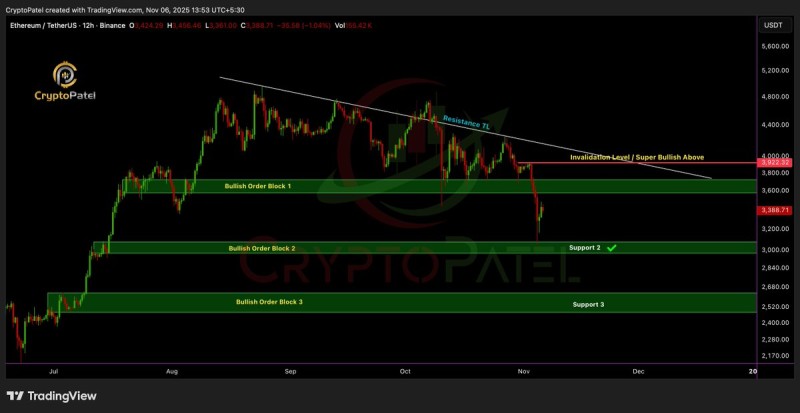Ethereum just delivered a textbook technical bounce—dropping straight into a key support zone near $3,057 and rebounding with precision. The move validated what swing traders have been watching for weeks: a bullish order block that's held up so far. But here's the catch—if ETH loses the $3,000 level, the next real support doesn't show up until much lower.
The Technical Picture
Technical analyst Crypto Patel captured the moment perfectly, reiterating his short-term bearish stance below $3,920 while keeping his eyes on massive long-term upside potential.

ETH's chart is telling a clear story right now:
- Descending resistance trendline has been rejecting price since early September, creating a series of lower highs
- $3,920 is the make-or-break level—below it, ETH stays vulnerable; above it, the structure flips bullish
- Three major support zones are in play: $3,650–$3,300 (broken and now resistance), $3,050–$3,000 (the current must-hold line), and $2,500–$2,200 (the deep safety net if $3,000 fails)
- The recent bounce came right at $3,057, confirming buyers are stepping in at this critical demand zone
As long as ETH trades under that descending trendline and below $3,920, sellers have the edge. But lose $3,000? Expect a quick trip toward $2,500.
What's Driving This Action?
ETH isn't moving in a vacuum. Macro pressure is hitting risk assets hard, liquidity is thin (making moves more dramatic), and capital has been rotating into Layer 2 tokens and AI plays—temporarily draining momentum from ETH itself. Still, underneath the volatility, there are signs of long-term accumulation, especially from larger players defending these support levels.
Short-term, ETH remains bearish below $3,920 and is still stuck under resistance. If $3,000 breaks, look for a move toward $2,500–$2,200. But hold that level? A recovery back above $3,300–$3,650 could shift sentiment and set up a run at the trendline.
Long-term, isn't backing down from his $10K–$15K targets. With ETH's dominance in DeFi, growing staking activity, expanding Layer 2 ecosystems, and post-Merge supply dynamics, the bigger picture still looks strong—even if the path there gets bumpy.
 Artem Voloskovets
Artem Voloskovets

 Artem Voloskovets
Artem Voloskovets


